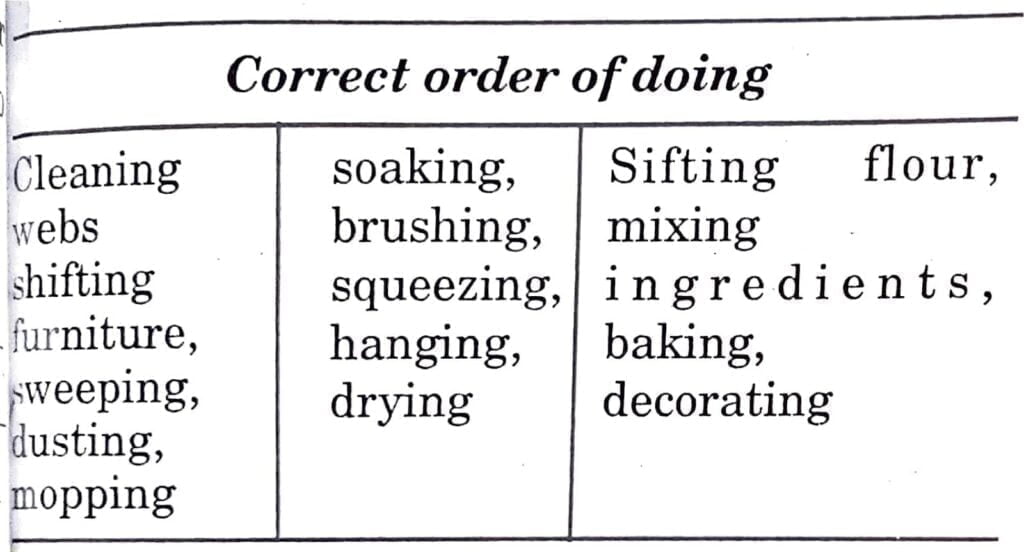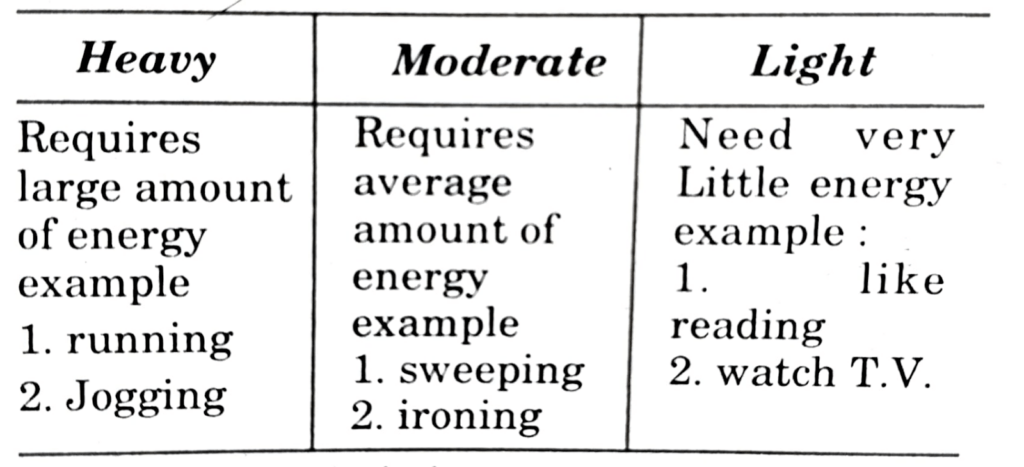NIOS Class 10 Home Science Chapter 15 Management of Time and Energy Solutions to each chapter is provided in the list so that you can easily browse through different chapters NIOS Class 10 Home Science Chapter 15 Management of Time and Energy and select need one. NIOS Class 10 Home Science Chapter 15 Management of Time and Energy Question Answers Download PDF. NIOS Study Material of Class 10 Home Science Notes Paper 216.
NIOS Class 10 Home Science Chapter 15 Management of Time and Energy
Also, you can read the NIOS book online in these sections Solutions by Expert Teachers as per National Institute of Open Schooling (NIOS) Book guidelines. These solutions are part of NIOS All Subject Solutions. Here we have given NIOS Class 10 Home Science Chapter 15 Management of Time and Energy, NIOS Secondary Course Home Science Solutions for All Chapters, You can practice these here.
Management of Time and Energy
Chapter: 15
[Book – II] HOME SCIENCE
TEXTUAL QUESTION WITH ANSWERS
Intext Questions 15.1.
Q.1. Classify the following activities into flexible and inflexible activities, keeping in mind that these are for your parents.
Ans:
| Activities | Flexible | Inflexible |
| Dusting and Mopping | F | |
| Cooking food | I | |
| Stitching clothes | F | |
| Going to school | I | |
| Washing clothes | F | |
| Going to shopping | F | |
| Preparing lunchbox for husband | I | |
| Going to marriage ceremony | F | |
| Ironing clothes | F | |
| Doing prayer | F |
Q.2. List the steps of making a time plan.
Ans: (a) Listing all the activities.
(b) Grouping flexible and inflexible activities.
(c) Estimating time required for performing each activity.
(d) Balancing.
Intext Questions 15.2.
Q.1. State whether the following statements are true or false. If false, write the correct statement below it:
(a) And energy are closely related to each other. True/False
Ans: True.
(b) Time can be utilized more effectively if time -plan is not made. True/False
Ans: False. Time can be utilized effectively only if time schedule is prepared.
(c) When we combine two or three activities together it is known as dovetailing. True/False
Ans: True.
(d) While preparing time plan there is no need to think about number of activities to be performed. True/False
Ans: False. Considering number of activities to be performed is very important while preparing time schedule.
Q.2. A list of some activities is given below. State whether light, moderate or heavy work is required to be done to perform these activities.
(a) Preparing notes ______________________.
Ans: Moderate.
(b) Mopping house ______________________.
Ans: Heavy.
(c) Diwali cleaning ______________________.
Ans: Heavy.
(d) Cycling ____________________.
Ans: Heavy.
(e) Listening to radio _____________________.
Ans: Light.
(f) Telling a story_______________________.
Ans: Light.
Intext Questions 15.3.
Q.1. List several ways by which the following persons will save energy while doing their work:
(a) A child studying in class V.
(b) A farmer.
(c) A housekeeper.
Ans: We can save energy by:
1. By doing the activities in a better order.
2. By cutting out all extra movement.
3. By being more skilled at our work.
4. By working the correct posture at work.
5. By working at proper heights.
6. By keeping things close at hand.
7. By using labour sewing device.
Q.2. Given below in the box are activities required to clean and rearrange the house. List them in the correct order in the space given below:
| Cleaning the house | Washing clothes | Making a stuffed parantha |
| Dusting, shifting the furniture, cleaning webs mopping, sweeping | Brushing, soaking, drying squeezing, hanging, | Rolling, making a ball, making dough, preparing filling, frying |
Ans:

Terminal Exercise
Q.1. What are the advantages of preparing a time plan?
Ans: Advantages of making a time:
1. We can finish all your work in limited time.
2. We can find time to rest.
3. We can find the time to do things which we like such as hobbies, playing watching movies etc.
4. We do more work.
5. Work done is of better quality.
Q.2. Differentiate between heavy , moderate and light work. Give one example of each.
Ans:

Q.3. Why is it important to categorize activities of work?
Ans: 1. Find time for rest and relaxation
2. Finish all your work efficiently with out feeling tired.
3. Do more productive work in less time.
4. Better quality of work is done.
5. You are saved from last minute tensions and confusion.
Q.4. What do you understand by the term dovetailing and how does it help to save time?
Ans: Doing two or more activities at the same time which is called as”dovetailing” of activities. Example:
1. Fill water in washing machine, add detergent and start washing.
2. Firs put water on stove for boiling dal.
3. Clean and wash dal and put it in water for cooking.
4. Wash and cut vegetables and keep for cooking.
5. Wash dishes while cooking and washing of clothes is going on.
6. Wind up kitchen cooking.
7. Wind up washing of clothes and drying .
Also while doing dishes you can listen to music or radio. Thus by dovetailing activities, we can save time.
Q.5. Your mother has to leave home for two days. All the family members have been assigned different tasks being performed by her. You have been assigned the task of cleaning the house.
Ans: 1. Make a list for all works.
2. Divides works on brother/sister.
3. Planning a time schedule then done for easily follow.
4. Use labour saving devices.
5. First: dusting rooms, sweeping, mopping (using on wipper).
6. Second: wash clothes (using on washing machine).
7. Third: my brother doing on Clothes ironing.
8. Fourth: my sister went to market purchased vegetables.
9. My mother not make a list for works and time plan.
10. She cannot use a thing of labour saving devices.
SOME OTHER IMPORTANT QUESTIONS FOR EXAMINATION
Multiple Choice Questions
Tick (✔) the correct answer:
1. An advance plan of what we are going to do in a given time period is termed as:
(a) Time plan.
(b) Energy plan.
(c) Energy management.
(d) None of the above.
Ans: (a) Time plan.
2. Time plan can be a plan for:
(a) Morning.
(b) Afternoon.
(c) Full day.
(d) All of the above.
Ans: (d) All of the above.
3. Which of the following is not an advantage of making a time plan?
(a) One can find time to rest.
(b) We can’t do more work.
(c) Work done is of better quality.
(d) Saves the last minute tensions and confusion.
Ans: (b) We can’t do more work.
4. Which of the following is an example of an impractical time plan?
(a) 7.00 am-7.05 am – is get ready for office.
(b) 9.30 am – 11.00am – finish cleaning the house.
(c) 11.00 am-11.30 am – bathe and get ready.
(d) 1.30p.m.2.00pm – clean the kitchen.
Ans: (a) 7.00 am-7.05am – is get ready for office.
5. We can save time by
(a) Not wasting time.
(b) Using labour saving equipment.
(c) Making time plans and strictly following them.
(d) All of the above.
Ans: All of the above.
6. Which of the following is not an advantage of an impractical time plan?
(a) There is no enough time for doing each activity.
(b) There is no extra time for unexpected happenings.
(c) Both ‘(a)’ and ‘(b)’.
(d) None of the above.
Ans: (c) Both ‘a’ and ‘b’.
7. The method in which two or three activities are done at the same time is known as:
(a) Dovetailing.
(b) Multifarious work.
(c) Multi Activities.
(d) None of the above.
Ans: (a) Dovetailing.
8. Time plan helps you:
(a) Finish all the work in time.
(b) Find time to rest.
(c) Find time to enjoy yourself.
(d) All of the above.
Ans: (d) All of the above.

Hi! my Name is Parimal Roy. I have completed my Bachelor’s degree in Philosophy (B.A.) from Silapathar General College. Currently, I am working as an HR Manager at Dev Library. It is a website that provides study materials for students from Class 3 to 12, including SCERT and NCERT notes. It also offers resources for BA, B.Com, B.Sc, and Computer Science, along with postgraduate notes. Besides study materials, the website has novels, eBooks, health and finance articles, biographies, quotes, and more.



